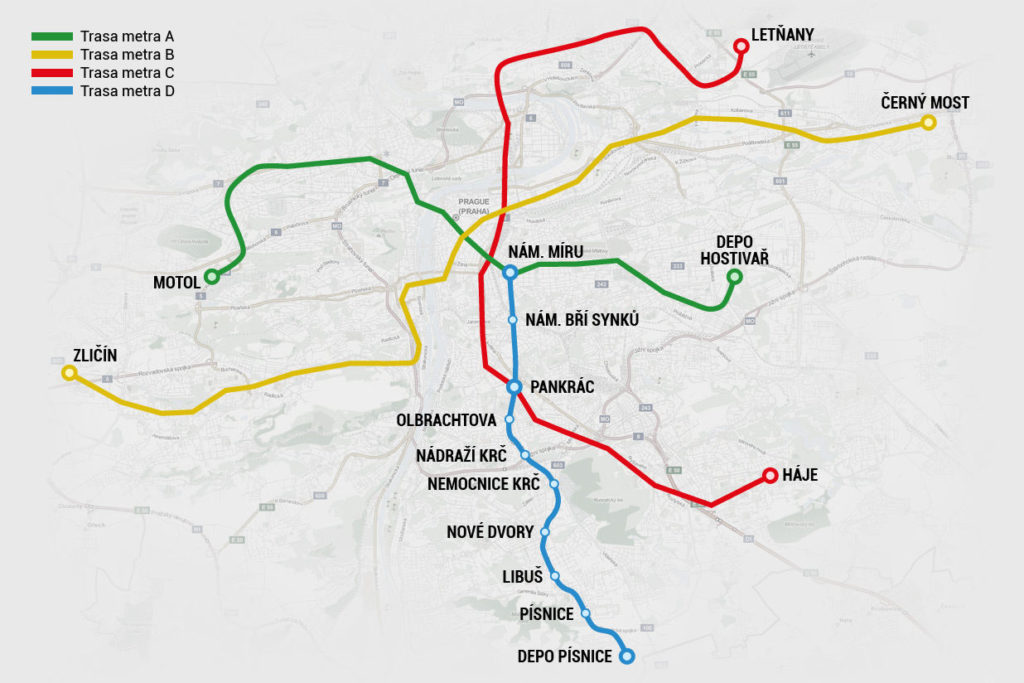From Thursday, April 30, passengers in the Prague metro can use the high-speed LTE mobile network between Muzeum and Můstek stations on line A, reports Mobilenet.cz.
About 20 stations are already covered with LTE services.
At the beginning of April, a consortium of operators launched covered the section between Křižíkova and Invalidovna on line B.
Construction works and cable installation in Prague Metro were performed in phases and during night hours when the metro is closed to the public (1:00 to 3:00 a.m.). The total distance between the four new stations where the cable will be installed in both directions is 11.6 km.
By the end of summer, the consortium wants to complete the coverage of metro sections in the city center. The LTE network should be extended to Staroměstská – Dejvická, Florenc – Českomoravská and Smíchovské nádraží – Anděl.
The costs of covering the Prague metro stations and the tunnels amount to CZK 12 million and CZK 18 million, respectively.
Where LTE network is currently working?
Line A: Bořislavka – Motol Hospital (4 stations: Bořislavka, Nádraží Veleslavín, Petřiny, Motol Hospital), Můstek – Muzeum (2 stations)
Line B: Křižíkova – Invalidovna (2 stations)
Line C: Nádraží Holešovice – Roztyly (12 stations: Nádraží Holešovice, Vltavská, Florenc C, Hlavní nádraží, Muzeum C, I. P. Pavlova, Vyšehrad, Pražského povstání, Pankrác, Budějovická, Kačerov, Roztyly)
The Prague metro began operation in 1974 and now has three lines with 61 stations. It currently has a transit network 65.2 kilometers long. This does not include the long-planned Metro D line.
Expanding WiFi coverage is part of a long-term city project not only for the metro. The Prague Public Transit Company (DPP) has introduced Wi-Fi in new Škoda 15T ForCity trams and some other trams as it modernizes the fleet. By 2022 DPP hopes to have 60 to 70 percent of the fleet covered with WiFi.
On Thursday, October 31, the Czech Senate approved the amendments to the law on railway transport, which allow the use of trains without drivers.
The construction of a new fourth metro line in Prague, which will be marked by “D” letter and blue color, will begin by the section from Pankrác to the Olbrachtova station and it should cost 39.7 billion crowns. The first section will also test the operation in automatic mode – without drivers, which will speed up the putting line D to operation.
Construction will be preceded by an archaeological survey that is set to begin this summer and is expected to take about a year.
Construction works on the line will be launched at Pankrác station, outside the Arkády shopping mall. This is where the tunnel boring machines will be brought under the ground. Construction of the Metro’s D route was originally supposed to start in 2010, but it was postponed due to various reasons, including problems with acquiring all of the lands.

The completion of the metro D construction will also mean a significant improvement in the environment. The amount of pollutants is expected to decrease by almost 60 tons per year. At the same time, the number of cars heading to the center will fall by more than 18 million a year.
Metro D is a planned subway line that will connect the city center to neighborhoods in the southern part of the city that now has poor public transportation options. The trains will be driverless.
According to City Hall, the first section of Metro D between Pankrác to Nové Dvory, should be put into operation by the end of 2027.
The Metro D line has faced numerous delays. Construction was originally supposed to start in 2010. There was a petition in 2016 to change the approved designs for the stations between Pankrác to Písnice because the designs are already outdated, and do not reflect current trends in mass transit.

